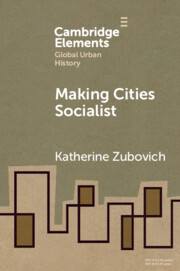194 results
Kautsky’s Unexpected Comeback: Understanding the Re-emergence of the Second International in Contemporary Debates
-
- Journal:
- International Labor and Working-Class History , First View
- Published online by Cambridge University Press:
- 19 September 2024, pp. 1-12
-
- Article
-
- You have access
- Open access
- HTML
- Export citation
Italy between liberalism and democracy: universal suffrage and the 1913 elections
-
- Journal:
- Modern Italy , First View
- Published online by Cambridge University Press:
- 19 September 2024, pp. 1-20
-
- Article
-
- You have access
- Open access
- HTML
- Export citation
Deradicalization and the Experience of Governing: Evidence from the Transformation of Socialist Parties in Western Europe, 1945–2021
-
- Journal:
- Social Science History , First View
- Published online by Cambridge University Press:
- 12 September 2024, pp. 1-24
-
- Article
-
- You have access
- Open access
- HTML
- Export citation
6 - An Excuse to Produce
-
- Book:
- Conversations with the Turtles
- Published online:
- 26 September 2024
- Print publication:
- 13 June 2024, pp 92-129
-
- Chapter
- Export citation
Chapter 20 - Morris and Marxism
- from Part V - Influences and Legacies
-
-
- Book:
- The Cambridge Companion to William Morris
- Published online:
- 03 May 2024
- Print publication:
- 23 May 2024, pp 271-282
-
- Chapter
- Export citation
Chapter 10 - Utopian Fiction
- from Part II - Authorship
-
-
- Book:
- The Cambridge Companion to William Morris
- Published online:
- 03 May 2024
- Print publication:
- 23 May 2024, pp 135-146
-
- Chapter
- Export citation
Chapter 11 - Morris’s Prose Romances and the Origins of Fantasy
- from Part II - Authorship
-
-
- Book:
- The Cambridge Companion to William Morris
- Published online:
- 03 May 2024
- Print publication:
- 23 May 2024, pp 147-158
-
- Chapter
- Export citation
Chapter 19 - Morris and John Ruskin
- from Part V - Influences and Legacies
-
-
- Book:
- The Cambridge Companion to William Morris
- Published online:
- 03 May 2024
- Print publication:
- 23 May 2024, pp 259-270
-
- Chapter
- Export citation
16 - Sexuality in Marxism and Socialism
-
-
- Book:
- The Cambridge World History of Sexualities
- Published online:
- 26 April 2024
- Print publication:
- 16 May 2024, pp 340-365
-
- Chapter
- Export citation
24 - Sex in Shanghai in the Twentieth Century: Intimate Negotiations
-
-
- Book:
- The Cambridge World History of Sexualities
- Published online:
- 26 April 2024
- Print publication:
- 16 May 2024, pp 508-531
-
- Chapter
- Export citation
Chapter 6 - Serving in a Socialist Home
- from Part II Introduction
-
- Book:
- Domestic Service in the Soviet Union
- Published online:
- 25 April 2024
- Print publication:
- 02 May 2024, pp 180-209
-
- Chapter
- Export citation
Conclusion
-
- Book:
- Domestic Service in the Soviet Union
- Published online:
- 25 April 2024
- Print publication:
- 02 May 2024, pp 273-286
-
- Chapter
- Export citation
Socialist Sex Education and Its Transnational Entanglements: Monika Krause and the Effort to “Teach Tenderness” to the People
-
- Journal:
- History of Education Quarterly / Volume 64 / Issue 2 / May 2024
- Published online by Cambridge University Press:
- 16 May 2024, pp. 164-192
- Print publication:
- May 2024
-
- Article
-
- You have access
- Open access
- HTML
- Export citation
2 - Origins
-
- Book:
- China's Age of Abundance
- Published online:
- 28 March 2024
- Print publication:
- 04 April 2024, pp 28-57
-
- Chapter
- Export citation
Chapter 16 - Revolutionary Politics
- from III - Politics, Ideas, and Bodies
-
-
- Book:
- Wagner in Context
- Published online:
- 14 March 2024
- Print publication:
- 14 March 2024, pp 159-167
-
- Chapter
- Export citation
13 - Postscript
-
-
- Book:
- Social Justice in Twentieth-Century Europe
- Published online:
- 29 February 2024
- Print publication:
- 07 March 2024, pp 267-272
-
- Chapter
- Export citation
8 - Immigrants and Social Justice in Western Europe since the 1960s
-
-
- Book:
- Social Justice in Twentieth-Century Europe
- Published online:
- 29 February 2024
- Print publication:
- 07 March 2024, pp 163-184
-
- Chapter
- Export citation
3 - Catholic Conceptions of Social Justice from 1891 to Pope Francis
-
-
- Book:
- Social Justice in Twentieth-Century Europe
- Published online:
- 29 February 2024
- Print publication:
- 07 March 2024, pp 53-77
-
- Chapter
- Export citation

Making Cities Socialist
-
- Published online:
- 02 March 2024
- Print publication:
- 04 April 2024
-
- Element
- Export citation
The Bilingualism Bonus in Socialist Slovenia: Domestic Policy or Diplomatic Prestige?
-
- Journal:
- Nationalities Papers , FirstView
- Published online by Cambridge University Press:
- 16 February 2024, pp. 1-18
-
- Article
-
- You have access
- HTML
- Export citation

